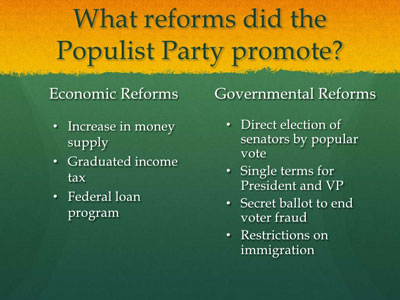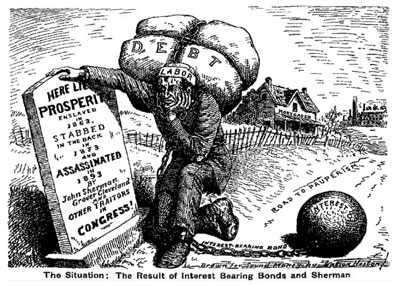This year we have heard much about the concept of Populism or Grass-Root politics.
Scholars often counterbalance the discussion with the introduction of Progressivism. So where and when did these terms pop up in our society? Are they similar or extremely different? I must confess that I am just an average citizen who attempts to make heads and tails out of today’s politics. But I will attempt to offer a little guidance on the historic aspects of the two.
The period between Reconstruction and World War II reflects strife between the common person and the elite, especially Robber Barons. Men with names like Astor, Rockefeller, Carnegie, and other multimillionaires in a time of abject poverty in parts of the country were targets of Populism. At the same time, another movement Progressivism appeared with the intent of making life cleaner, healthier, and better in general for everyone. I will try to compare and contrast the two.

Tenets of the Populist Party when first organized in 1891. Most of these proposals were eventually met. Today more urgent concerns are addressed by the unorganized populist party.
Let’s start at the bottom and work our way to the top. Populism was really organized by farmers about 1891. If you farm, you need to sell your product as soon as possible. Milk, eggs, vegetables, chickens, and all farm products do not last until prices rise and prices were falling every week.
One of the strongest leaders of the Populist Party was William Jennings Bryan who ran for president three times and was finally appointed Secretary of State under President Woodrow Wilson. Bryan blamed all the nation’s woes on Wall Street. He preached that if the gold standard was abolished and silver replaced it, all would be fine. (Franklin Roosevelt abolished the Gold Standard while president.)
So we have the Populists supporting silver standard and aid for farmers. However, factory workers felt deprived also. Many populists felt that the increase of immigrants had hurt labor. Of course, we should throw all the factory owners and railroad giants into the mix since they charged such exploitive fees and paid so little in salaries.
Now on another level we have those who wished to see better health conditions, better child care, more sober and responsible adult men among other issues. Progressivism began after the Civil War with prohibition and continued at a rapidly growing pace until the 18th Amendment went into effect. Along the way, kindergartens and high schools were added to school systems, milk was tested for purity, and among the horrors, women were given the right to vote.

The Sherman referred to in this cartoon was Senator John Sherman of Ohio who also served as Secretary of State and Secretary of State. He is known for targeting monopolies and anti-competitive behavior of industry. Labor elites blamed Sherman and others for what they believed were laws to break their hold over employees. His older brother was General William T. Sherman of Civil War fame.
Progressivism was not a grass-root concept as populism was. It started when the more elite of a community began to see changes that should be made. Men and women of respectable stature, not the more common laborers, headed most progressive movements. In a way, it was the upper class controlling the lower classes.
However, with the exception of prohibition, most progressive movements are now acceptable to everyone. But populism rears its head regularly throughout the United States and other Western countries. Somehow I think the two “isms” will be with us for a long time.
To put it more succinctly a friend of mine says it’s all about control. The Populists are controlling from the bottom up and the Progressives hope to rule from top down. The rest of us are caught in the middle.
